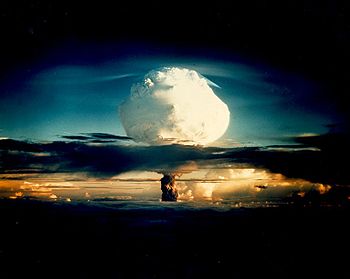
Fusion energy gain factor
Encyclopedia

Fusion power
Fusion power is the power generated by nuclear fusion processes. In fusion reactions two light atomic nuclei fuse together to form a heavier nucleus . In doing so they release a comparatively large amount of energy arising from the binding energy due to the strong nuclear force which is manifested...
produced in a nuclear fusion
Nuclear fusion
Nuclear fusion is the process by which two or more atomic nuclei join together, or "fuse", to form a single heavier nucleus. This is usually accompanied by the release or absorption of large quantities of energy...
reactor to the power required to maintain the plasma in steady state
Steady state
A system in a steady state has numerous properties that are unchanging in time. This implies that for any property p of the system, the partial derivative with respect to time is zero:...
. The condition of Q = 1 is referred to as breakeven.
In a fusion power reactor a plasma must be maintained at a high temperature in order that nuclear fusion can occur. Some of this power comes from the fraction fch of the fusion power contained in charged products Pfus which remain in the plasma. This power may be designated fchPfus. The rest, designated Pheat comes from external sources required for heating, some of which may also serve additional purposes like current drive and profile control. This power is lost through various processes to the walls of the plasma chamber. In most reactor designs, various constraints result in this heat leaving the reactor chamber at a relatively low temperature, so that little or none of it can be recovered as electrical power. In these reactors, electrical power is produced from the fraction of the fusion power contained in neutrons, (1-fch)Pfus. The neutrons are not contained by the magnetic fields (in magnetic confinement fusion) nor the dense plasma (in inertial confinement fusion
Inertial confinement fusion
Inertial confinement fusion is a process where nuclear fusion reactions are initiated by heating and compressing a fuel target, typically in the form of a pellet that most often contains a mixture of deuterium and tritium....
) but are absorbed in a surrounding walls (blanket). Due to various exothermic
Exothermic
In thermodynamics, the term exothermic describes a process or reaction that releases energy from the system, usually in the form of heat, but also in the form of light , electricity , or sound...
and endothermic
Endothermic
In thermodynamics, the word endothermic describes a process or reaction in which the system absorbs energy from the surroundings in the form of heat. Its etymology stems from the prefix endo- and the Greek word thermasi,...
reactions, the blanket may have a power gain factor a few percent higher or lower than 100%, but that will be neglected here. The neutron power would be used to heat a working medium such as helium gas or liquid lithium to a high temperature, and the working medium is then used to produce electricity at some efficiency ηelec, so that Pelec = ηelec(1-fch)Pfus. A fraction frecirc of the electrical power is recirculated to run the reactor systems. Power is needed for lighting, pumping, producing magnetic fields, etc., but most is required for plasma heating so we can write Pheat = ηheatPelec, where ηheat is substantially the efficiency with which electrical power is converted to the form of power needed to heat the plasma.
The heating power can thus be related to the fusion power by the following equation:

The fusion energy gain factor is then defined as:

For the D-T reaction, fch = 0.2. Efficiency values depend on design details but may be in the range of ηheat = 0.7 and ηelec = 0.4. The purpose of a fusion reactor is to produce power, not to recirculate it, so a practical reactor must have frecirc = 0.2 approximately. Lower would be better but will be hard to achieve. Using these values we find for a practical reactor Q = 22. Of course, Q = 15 might be enough and Q = 30 might be achievable, but this simple calculation shows the magnitude of fusion energy gain required.
The goal of ignition, a plasma which heats itself by fusion energy without any external input, corresponds to infinite Q. Note that ignition is not a necessary condition for a practical reactor. On the other hand, achieving Q = 20 requires quality of confinement almost as good as that required to achieve ignition, so the Lawson criterion
Lawson criterion
In nuclear fusion research, the Lawson criterion, first derived on fusion reactors by John D. Lawson in 1955 and published in 1957, is an important general measure of a system that defines the conditions needed for a fusion reactor to reach ignition, that is, that the heating of the plasma by the...
is still a useful figure of merit. The condition of Q = 1 is referred to as breakeven. It is somewhat arbitrary, but it does mean that a significant fraction (20%) of the heating power comes from fusion, so that fusion heating can be studied. Above Q = 5 the fusion heating power is greater than the external heating power.
The one channel of energy loss that is independent of the confinement scheme and practically impossible to avoid is Bremsstrahlung
Bremsstrahlung
Bremsstrahlung is electromagnetic radiation produced by the deceleration of a charged particle when deflected by another charged particle, typically an electron by an atomic nucleus. The moving particle loses kinetic energy, which is converted into a photon because energy is conserved. The term is...
radiation. Like the fusion power density, the Bremsstrahlung power density depends on the square of the plasma density, but it does not increase as rapidly with temperature. By equating the two power densities, one can determine the lowest temperature for which the fusion power can overcome the Bremsstrahlung power. This ignition temperature is about 4 keV for the D-T reaction and about 35 keV for the D-D reaction.

